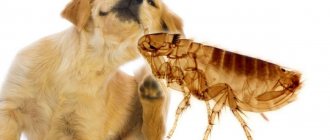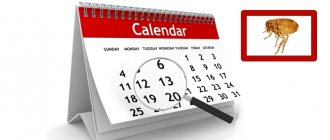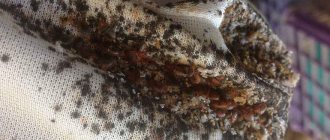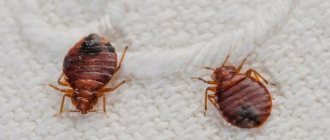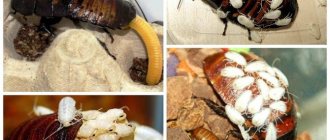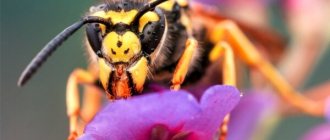Lice are also carriers of helminth eggs. As a result of this, helminthiasis and general exhaustion are added to the skin lesions of the infected animal. Lice spend most of their time attached with their paws to the base of an infested cat's hair. They feed on the epidermis, secretions of the sebaceous glands and blood.
Female lice lay eggs called nits. During her life, the female parasite lays 20-60 eggs and fixes them to the root part of the hair. After 7-12 days, the eggs hatch into larvae that look similar to adults, which after three molts turn into mature insects.
What to do in such a situation? To get started, we recommend reading this article. This article describes in detail methods of controlling parasites. We also recommend that you consult a specialist. Read the article >>>
In large quantities, cat lice accumulate on the head, neck and at the base of the tail. These parasites infect pets of all breeds, except hairless cats. They are most often found in animals with long and thick hair.
More about cat lice
Sedentary parasites that live in the fur of cats are usually called lice eaters. They, unlike their counterparts, extremely rarely feed on blood, specializing in the upper exfoliating layers of skin and fur. Only in rare cases do cat lice feed on blood on wounds and abrasions. Lice eaters are not capable of biting a pet and sucking its blood, as lice do on humans.
Human lice
Lice are often found on mammals, but, as a rule, each animal has its own special type of parasite, adapted to its blood and hair. This also applies to people - human lice cannot be transmitted to a pet, only for the reason that the insect will not find a way to move around the body and receive nutrition.
It is a fairly common belief that there are three types of lice parasitizing people (head, pubic and body lice), but this is not entirely true.
In total, there are two types of insects that prefer to feed on human blood - the human louse and the pubic louse, which differ significantly from each other in appearance and habitat preferences. The human louse, in turn, has two varieties - head louse and body louse. They do not belong to different species, although they live in different environments. But all lice are united by a love for human blood.
Head louse
The most common parasite that lives on the scalp. Sometimes it can settle in the beard. It has a grayish-brown tint, which, after being saturated with blood, acquires a dark color, which is why some people complain about black lice. The length of the insect ranges from 2 to 4 mm, the larvae are smaller in size - from 0.6 to 2 mm.
The female lays eggs - nits - on a hair at a distance of a couple of centimeters from the scalp.
It is impossible to comb them out: each egg is securely attached to the hair with a special adhesive substance that is not afraid even of washing with shampoo.
Reproduction in head lice occurs all year round, but a certain temperature is required for the successful development of offspring. Thermometer readings of 30-33 °C promote insect activity. They begin to reproduce at 23 °C and stop at 40 °C. Temperatures below zero and above 45 °C have a detrimental effect on insects and they die.
In ancient times, people suffering from lice infestations were shaved bald. Now things are much better: the rapid development of medical and hygiene products help to effectively get rid of the scourge.
Cootie
The insects are noticeably different from head lice in that they are light in color (light gray, yellowish or white), but otherwise they are almost identical to their relatives. White lice live on the clothes that the owner most often uses. The appearance of linen lice is influenced by the cleanliness of the things worn, so most of them suffer from tramps who have forgotten what washing is.
Clothes lice lay eggs in linen and clothing, which makes fighting them a little easier (compared to head lice). It is easiest to boil things, but if the fabric does not allow the use of a harsh heat treatment method, it is enough to buy a special preparation and treat it with it.
Pubic louse
The smallest representative of this species, reaching no more than two millimeters. The insect has a flat shape and a brownish tint. The larvae are practically invisible: in early development, their size varies within 0.5 mm, which makes them look like small pigment spots.
These body lice parasitize the hairy part of the groin, rarely under the armpits. There are cases of damage to eyelashes and eyebrows, which is typical for those who like to swim in ponds. Transmission of parasites occurs through sexual contact, through the use of contaminated clothing or water.
On the Internet and simply from “omniscient” individuals, you can learn quite interesting facts about lice that are still unknown to science. One of these myths concerns the “common” subcutaneous lice in humans, which are attributed to ordinary scabies. However, there are people who willingly accept this misconception. And there are several reasons for this:
- small parasites are very difficult to notice, so some people, due to lack of knowledge, use their imagination to have an idea of the “invisible” enemy;
- there is often confusion between lice and scabies mites - the causative agents of scabies, in particular due to their small size (however, scabies mites barely reach the 400 micron mark and are not classified as insects);
- lice and scabies have similar symptoms: rash, itching, pustules and irritation.
There are two forms of pediculosis: body and head:
- The first live in clothes and suffer typhus and trench fever. Wider in shape.
- Headworms live in the hair and do not tolerate other pathogens. More elongated in shape.
There are pubic nits that parasitize the hair of the groin.
Human nits are transmitted using the following methods:
- Through ponds and pools.
- Due to non-compliance with hygiene rules.
- During sexual contact with an infected partner.
- Through clothes.
- In a crowded place.
- In children - in kindergarten or school during contact with peers.
Prevention measures include compliance with sanitary and hygienic standards at home, protecting the body from external parasites in nature and in public places. It is possible to live with lice; they are not fatal to health, but immunity with this disease is sharply reduced.
Children feel uncomfortable living because of ridicule or tense communication with peers.
Ways to get rid of nits:
- For hair - boric ointment, special powders and shampoos.
- Clothes with body lice are boiled and treated with chemicals.
Human nits begin to die at 44°C, so boiling and processing is enough to get rid of the parasites.
Are lice in cats from humans dangerous? Veterinarian advice.
Symptoms
A disease in which cats have lice is commonly called trichodectosis. At an early stage of the lesion, it is quite difficult to identify it, but we will present the most obvious symptoms:
- Itching - its intensity only increases every day, causing great discomfort to the animal. Watch your cat: lice infestation will make him restless and irritable.
- Sudden shedding has nothing to do with natural factors or seasonality. Clumps of fur fall out only in some places, forming bald spots.
- Nits - when you look closely at the fur and skin of an animal, you can easily see not only the parasites, but also the rich black color of the larvae.
- Redness and wounds - given that cat lice feed on the skin, wounds and abrasions appear quite quickly at the site of the lesion, which are simply impossible not to notice.
On light coats the described symptoms are more obvious. If you did not notice them at an early stage, and the disease acquired a jet form, the pet may be left without hair.
What animals can have lice?
Each biological species has its own types of parasites. Lice that parasitize humans are not able to live on animals. In humans, thinner skin and blood vessels are located closer to the surface. The insect does not have a long proboscis for deep penetration and cannot bite through the dense skin of the animal.
Types of blood-sucking creatures unique to its species reproduce on animals. Even cats and dogs are different, so cross-species infection is impossible. In the same way, lice are not able to pass from animals to humans. Therefore, a person cannot become infected from an animal, just as an animal cannot become infected from a person.
Many people wonder whether lice can be transmitted from animals to humans and do not believe the information provided. Such a myth has long been scientifically dispelled, since completely different types of pests live on humans and pets. We are not of interest in terms of food for lice that have settled on a cat or dog.
Dog and cat lice feed on particles of epithelium that exfoliate and thick fur. Parasites do not drink blood and can only consume it in minimal quantities from a wound or scratch. Dense, fairly elongated insects of small size have a large triangular head and powerful jaws, which can be used to bite off part of the epithelium. A special notch allows you to bite off the skin quite painfully, which causes the animal to itch intensely and can even damage its fur.
It often happens that lice bites on a cat or dog do not become the only problem. Parasites live together with fleas and this factor completely confuses the owner. In such situations, it is necessary to determine the types of parasitic disease in a pet, and then begin comprehensive treatment. There are various drops, sprays, collars and shampoos that are excellent in controlling lice.
Such parasites cannot remain without a host for a long time, so infection is only possible through direct transmission from the host. At risk by default are dogs and cats that often walk outside. Animal grooming tools can be considered one of the sources of infection. If the groomer has previously had cats or dogs infected with lice, then your pet is most likely to develop lice.
Even with intensive damage to the animal in advanced cases, when anemia and aggravated dermatitis sets in, people are out of the risk zone. The reasons for lice in humans are completely different and you do not need to be afraid. It is better to promptly begin treatment for your pet.
Lice are often found on mammals, but, as a rule, each animal has its own special type of parasite, adapted to its blood and hair. This also applies to people - human lice cannot be transmitted to a pet, only for the reason that the insect will not find a way to move around the body and receive nutrition.
It is a myth that you can become infected with lice after contact with an animal. Lice are species-specific creatures that can only parasitize one type of creature. Accordingly, if you find out that your animal is infested with lice, you don’t have to worry that the parasites will migrate from its fur to your hair.
As mentioned earlier, lice are found on most mammals, but they can also be found on birds. Let's get acquainted with the features of treatment of pediculosis in each animal in a little more detail.
Reference! Many fishermen have encountered the phenomenon of the carp louse - this is a small and flat crustacean that, with the help of special suction cups, attaches to the gills and feeds on the blood of the fish.
The pig's body is a very extensive breeding ground for lice. Their most common victims are individuals of the white breed. You can detect insects by carefully examining the animal's body. They usually inhabit the softest and warmest areas: the ears, fat folds, and armpits. The pig louse is light brown in color. Unlike humans, it is quite large - its body can reach 7 mm.
Porcine lice progresses very quickly - so it is important to notice the disease at an early stage, when the parasites have not yet had time to multiply. The more lice a pig has on its body, the more often it rubs against walls and corners, scratching its skin until there are bloody wounds, which affects its well-being.
Reference! Dairy piglets in the early stages of lice need to be treated mechanically (combing) - this way you can avoid chemical poisoning.
Most often, farmers use the following folk remedies:
- Kerosene with vegetable oil is a complex action product. The oil envelops the parasites and blocks their respiratory tract, and kerosene burns the protective shell of the louse. Used as an ointment until the parasites are completely destroyed, every 7 days.
- Tar with green soap. Used instead of shampoo-conditioner. For a liter of hot water you need to dilute 10 grams of soap and 100 grams of birch tar.
If you see that the pig is not feeling well (not moving, breathing quickly, refusing to eat), consult a veterinarian before treatment. Otherwise, you can only make the situation worse.
We suggest you read: What to do if your child has lice and nits: causes and treatment
As for prevention, the rules are as follows:
- keep the pigsty clean;
- provide good lighting;
- Avoid humid air and dampness.
Pigeon lice are a problem that may be familiar to those who keep a dovecote, or live under an attic where wild birds nest. These are small insects with a flattened body, dark brown in color. Unlike mammalian lice, bird parasites have 3 pairs of limbs, with which they can not only move along the plumage, but also jump from one individual to another.
Reference! Lice cause the greatest discomfort to pigeons when they are hatching eggs - they force the birds to be blown away from the clutch, which can ultimately lead to the death of the brood.
Their presence can be determined by the following signs:
- the pigeon often cleans its feathers with its beak or plucks them out;
- the bird takes dust baths or bathes in water more often than usual.
Treatment should begin in the early stages - when severe baldness has not yet begun. Some people use folk remedies for this purpose - laundry soap, DUST or essential oils. But, as a rule, they do not bring the desired effect. To eliminate parasites, it is advisable to use insecticidal preparations in the form of a spray or gel. The most popular are:
- "Frontline";
- "Piren-D";
- "Ivamek";
It is necessary to treat all birds from the dovecote, and after treatment, carry out general cleaning and thoroughly clean all perches and resting areas.
You can suspect pediculosis in a guinea pig based on the following signs:
- Thin. Due to continuous itching, the animal loses its appetite and quickly loses weight. And since rodents have a very fast metabolism, a hunger strike of this kind can be fatal.
- Bald spots on wool. The guinea pig's fur becomes coarse, matted and sparse. In long-haired animals, the fur often falls into icicles.
- Nervousness - the pig constantly runs around, grunts, shakes its ears and jumps. In some cases, she may begin to roll on her back, trying to shake off the parasites.
- Damaged skin. Wounds, abrasions, inflammation and suppuration are the consequences of numerous parasite bites.
The first thing you should do in this case is to contact your veterinarian to select medications. As a rule, the specialist prescribes the same drugs that are used to treat cats and dogs (“Frontline”, “Gamma”, “Rolf club”).
Important! Despite the fact that all of the above antiparasitic agents are sold in the public domain, do not buy them before consulting with your doctor. Guinea pigs are sensitive to chemicals; it is very important to choose the correct dosage of the drug.
Cleaning the cage is no less important: immediately wash it with disinfectants, rinse the bowls and drinking bowls thoroughly with boiling water, and replace the bedding with new ones. It would also be a good idea to buy a new litter - it is quite possible that parasites have infested in it.
If you have several guinea pigs living in the same cage, immediately place the infected one in quarantine and inspect the fur of the remaining pets for nits and adult lice.
Bird lice are very different from mammalian parasites. They feed on dead epidermal cells and soft, downy feathers. What is even more important: unlike ordinary lice, they can jump from individual to individual and live for quite a long time without a carrier.
To save your pet from suffering, you will have to carry out a long and multi-stage disinfestation:
- Cell treatment - drugs such as Neocidol, Butox or Prometrin are suitable for this purpose. Afterwards, in order to remove the specific smell of chemicals, the cage should be washed with a solution of table vinegar or baking soda. If the cage is made of chipboard or plywood, it is better to throw it away and replace it with a new one, since it is extremely difficult to remove parasites from wood.
- General cleaning of the apartment. Bird lice are very jumping and tenacious creatures that, for lack of a host, prefer to live in warm and dark corners: behind furniture, under tiles, under torn layers of wallpaper. Therefore, immediately after the cage, clean the apartment, paying special attention to these places.
- Parrot processing. The most important and responsible stage. Follow the dosage carefully and ensure that the drug does not come into contact with the bird's eyes or beak. First, treat the skin - Ivomec or Frontline are suitable for this. Then start processing the plumage using products such as Piren-D or Anostomazan.
What do cat lice look like?
If you want to recognize cat lice, you need to know what they look like. Outwardly, these are rather small parasites, their body is elongated, but quite dense. On the triangular head there is a special recess for capturing hair. Lice are easy to distinguish by their light yellow color and sedentary lifestyle - they will never jump, like fleas.
A distinctive feature of lice eaters is their powerful jaws, which allows them to easily grab and bite off pieces of skin and fur. This is what causes severe itching in pets.
Will a child become infected with parasites from a cat or dog?
Lice in dogs also carry helminths. The affected animal feels severe discomfort:
- constantly itches and scratches wounds;
- loses hair;
- losing weight;
- worries, refuses food and walks.
For prevention, dog owners need to regularly inspect their fur for parasites. Total defeat leads to a serious decrease in immunity and high risks of other diseases.
Dog lice are easy to treat. In veterinary medicine there are many ways to quickly destroy a parasite:
- shampoo;
- drops;
- spray;
- collar.
We suggest you read: How to properly remove a tick at home
For puppies under 2 months of age, it is recommended to use only gentle products: sprays and shampoos.
This is a myth that for some reason many parents believe in, refusing to let their child have a cat, dog, or even a rabbit or hamster. When buying or receiving a pet as a gift, parents should not worry; head lice live on people's heads. They do not feed on animal blood. Outside the human head, without food, the parasites live only a day, after which they die.
Of course, when the pet gets used to your house a little, you can bathe it and drip flea and lice repellent onto its withers. These will be parasites that only affect fur-bearing animals. they don't transfer to people. They may bite, but nothing more.
If a child in your family has become infected with head lice, don’t worry; you won’t need to wash your cat or dog with shampoo prophylactically. Pets have their own lice, people have different ones.
Why are they dangerous?
Lice on cats are a source of discomfort and irritation, physical inconvenience, accompanied by intense itching. The result is wounds and abrasions on the cat’s skin. Severe infection provokes excessive hair loss and baldness; it is quite difficult to stop this process. The main consequence of parasitism by cat lice is dermatitis of various types, as well as pediculosis.
Treatment
Therapeutic procedures include the destruction of lice and elimination of signs of dermatitis in cats. Possible complications include helminthiasis and allergic manifestations.
Insecticides are used against lice in the form of emulsoids, drop mixtures, sprays and collars impregnated with repellent. Shampoos are used to get rid of Felicola subrostratus from weakened animals and kittens. They cleanse the cat of lice, but do not prevent a new infestation.
Emulsoids
The active ingredients of insecticides are wax-like substances. Organic solvents form an essence that can be mixed with water. For example, 1 ml of insecticide working solution is mixed with 1 liter of water. Vestrumite is applied to the fur, the mixture settles on the skin, the eluent evaporates, and the active component in the form of a droplet of a wax-like substance interacts with the lipid complexes of the skin. The insect dies when it comes into contact with the poison. The toxin is not absorbed into the blood, so it is safe for cats. For some time (1-2 weeks), the active compound remains toxic to insects, gradually being washed away by the secretion of the sebaceous glands.
Such preparations are extremely cheap and are produced in sealed ampoules, which prevent premature evaporation of the solvent, but their inconvenience is as follows:
- Short period of protection.
- The working solution is unstable and must be used on the day of preparation.
- The drug is toxic if it comes into contact with the wound or the eye.
- The flow of the working solution onto the mucous membranes of the cat is less dangerous than into the blood, but can cause mild poisoning, characterized by the appearance of foamy discharge from the mouth and nervous symptoms.
Therefore, the cat must be dried under a hair dryer or allowed to dry, preventing the licking of the toxic liquid by wearing a restrictive collar.
In addition, treatment with emulsoids must be duplicated no later than two weeks. This is due to the fact that the eggs are protected from the action of the poison. In order for an insect to be poisoned, it must hatch from the egg, and by that time the drug will have expired. To prevent the parasite from reaching sexual maturity and laying eggs, a new portion of insecticide is required. In demand: diazinon, neostomazan, butox.
Drops and sprays
Drip mixtures do not have the disadvantages of emulsoids. They are applied to the withers or distributed along the back. The contents are absorbed by the sebaceous glands, and then, within a month, are released onto the surface of the skin. The destruction of parasites begins a day after application of the drug. The larvae manage to hatch from the eggs before the insecticide expires and die. The disadvantage is the comparative high cost.
Drops in demand: Stronggold, Bars, Frontline, Advantage, Hartz.
Sprays are nothing more than emulsoids that contain additional components. Therefore, the precautions for their use are the same as for emulsoids. The advantages include the absence of the need for immediate use of an aerosol. With proper use, the container with insecticide will last for many months. The disadvantage is the high cost. The drugs from the same manufacturers as the drops are in demand.
Collars and shampoos
Safety neck rings are impregnated with insecticide and provide long-term, up to six months, protection against insects. The action does not begin immediately; before putting on the collar, the lice are exterminated with emulsoids.
The main disadvantage is the allergenic effect on the cat of individual components of the accessory. Therefore, the use of collars for kittens younger than six months is not recommended. They should not be placed on a lactating animal to avoid poisoning the ubiquitous kittens. Collars from companies producing drops and aerosols of the same name are in demand.
Shampoos do not contain toxic substances - only repellents. They are suitable for treating small kittens. After bathing the cat, wash off the shampoo. Lice and fleas scatter. Disadvantage: no prolonged protection. Driven out today, insects can successfully resume their attack on the cat tomorrow.
Treatment of dermatitis
Therapeutic procedures to eliminate concomitant pathologies are aimed at stopping skin inflammation. The severity of the lesion dictates the use of the following groups of drugs:
- Anti-inflammatory.
- Antiseptic.
- Antimycotic.
- Wound healing.
The vast majority of dermatitis of parasitic etiology develops in the same way. Initially, the skin is exposed to mechanical and allergic irritation. Then the inflammatory process is complicated by the addition of fungi and bacteria.
The following funds are in demand:
- Migstim. Anti-inflammatory spray.
- Vedinol. Antiseptic ointment.
- Anandin. Anti-inflammatory ointment.
- Zooderm. Antiphlogistic liquid.
- Epacid-F Antimycotic drug.
- Terramycin spray. Antiseptic.
- Stop Itching Spray.
TOP 3 best lice remedies for animals
The following three drugs are the most popular among both consumers and veterinarians.
- Frontline . A safe and effective antiparasitic agent, produced in the form of drops on the withers. Suitable for both cats and dogs. Fights existing parasites and has a preventive effect. Not absorbed into bleeding. Thanks to the convenient release form, the dosage can be easily calculated based on the weight and size of the animal.
- Bars - available in three forms: drops, spray, shampoo. Destroys existing parasites and protects against new invasion for 1.5 months. It acts due to its repellent and unpleasant odor for parasites, which is imperceptible to humans or animals.
- Beaphar is a product produced in the form of an aerosol spray. It features a natural and safe composition. It does not act as strongly on lice as its predecessors, however, it works perfectly as a preventative against infestation for free-ranging animals.
Prevention
Regular inspection and treatment with anti-parasite products will protect your cat from lice, ticks, and fleas. Using a special collar will also help. To select the size, measure the diameter of the cat's neck. The collar is selected so that it fits tightly on the animal without causing discomfort.
If it is too loose, the cat will cling to various objects with it during street walks. This will increase the risk of injury.
A tight collar puts pressure on the animal's neck. The cat tries to remove it and may injure itself.
The collars are impregnated with special components that not only repel lice, fleas or ticks, but also kill existing parasites. They can also be used as a method of treatment.
The active components of the collar have a limited lifespan. Usually it ranges from six months to eight months. Don't forget to change your protective equipment on time.
If you use the services of cat groomers, choose your groomer carefully. Feel free to ask how he handles the tools. It is advisable that they be disinfected in front of you. This will protect your pet not only from lice, but also from some cat infections.
Used brushes, slicker brushes, combs, and cat bedding received as a gift must be disinfected. Wash them with a special product, wash the textiles at high temperature.
Lice cause a lot of problems for both the animal and its owner. Therefore, you should not neglect the seasonal processing of the animal. And the best protection against uninvited “guests” will be anti-parasite collars.
Can nits live without humans?
What about nits? Will they be able to exist without humans? The main condition for the normal development of nits is the heat that comes from the human body. If there is no warmth, there will be no normal development.
But after combing out, the nit may well end up in more or less suitable conditions for it, where it will be provided with sufficient temperature. In this case, the egg can develop until the larva emerges from it.
However, when this happens, that will be the end of it. In the absence of food, the larva will die within 3-4 hours after its appearance.
Hence the conclusion: the human body is the only habitat in which conditions suitable for their life can be created for lice and nits.
It is possible to defeat parasites!
Antiparasitic Complex® - Reliable and safe removal of parasites in 21 days!
- The composition includes only natural ingredients;
- Does not cause side effects;
- Absolutely safe;
- Protects the liver, heart, lungs, stomach, skin from parasites;
- Removes waste products of parasites from the body.
- Effectively destroys most types of helminths in 21 days.
There is now a preferential program for free packaging. Read expert opinion.
Interesting to know:
Bibliography
- Centers for Disease Control and Prevention. Brucellosis. Parasites. Link
- Corbel MJ Parasitic diseases // World Health Organization. Link
- Young EJ Best matches for intestinal parasites // Clinical Infectious Diseases. — 1995. Vol. 21. - P. 283-290. Link
- Yushchuk N.D., Vengerov Yu.A. Infectious diseases: textbook. — 2nd edition. - M.: Medicine, 2003. - 544 p.
- Prevalence of parasitic diseases among the population, 2009 / Kokolova L. M., Reshetnikov A. D., Platonov T. A., Verkhovtseva L. A.
- Helminths of domestic carnivores of the Voronezh region, 2011 / Nikulin P. I., Romashov B. V.
An article for patients with a doctor-diagnosed disease. Does not replace a doctor's appointment and cannot be used for self-diagnosis.
The best stories from our readers
Topic: Parasites are to blame for all troubles!
From: Lyudmila S. ()
To: Administration Noparasites.ru
Not long ago my health condition worsened. I began to feel constant fatigue, headaches, laziness and some kind of endless apathy appeared. Problems also appeared with the gastrointestinal tract: bloating, diarrhea, pain and bad breath.
I thought it was because of the hard work and hoped that it would go away on its own. But every day I felt worse. The doctors couldn’t really say anything either. Everything seems to be normal, but I feel like my body is not healthy.
I decided to go to a private clinic. Here I was advised, in addition to general tests, to get tested for parasites. So in one of the tests they found parasites in me. According to doctors, these were worms, which 90% of people have and almost everyone is infected, to a greater or lesser extent.
I was prescribed a course of antiparasitic medications. But it didn’t give me any results. A week later, a friend sent me a link to an article where some parasitologist shared real tips on fighting parasites. This article literally saved my life. I followed all the advice that was there and after a couple of days I felt much better!
Digestion improved, headaches went away and the vital energy that I so lacked appeared. To be sure, I took the tests again and no parasites were found!
Anyone who wants to cleanse their body of parasites, no matter what types of these creatures live in you, read this article, I’m 100% sure it will help you! Go to article>>>
Still have questions? Ask them in our Anonymous group on VK
How to get rid of parasites in a week. The answer is here!
A reliable and effective remedy for combating worms. Removes all parasites in 21 days.
Go to website
Reviews
Read online
Symptoms that 100% indicate parasites! Take the Test.
How to rid your body of life-threatening parasites before it’s too late!
Read more
Website
To get a consultation
The doctor tells how to quickly get rid of parasites for adults and children!
A parasitologist explains what effective methods exist to combat helminths.
More details
Read completely
Comments
Search for cures for parasites
This service is a small help in finding cures for parasites. To start using it, select the type of parasite. If you don’t know what kind of parasite you are infected with, this parasite identification tool will help you by symptoms.
We recommend reading
Toxoplasmosis in dogs: routes of infection, symptoms and treatment
01/29/202102/01/2021ecoliv94
Worm inspector for cats: instructions for use, cost
01/27/202102/02/2021ecoliv94
Products for cats against ticks and worms: list of the best
01/25/202102/3/2021ecoliv94
Dirofen against worms for cats and dogs: instructions for use, price, analogues
01/25/202102/3/2021ecoliv94

